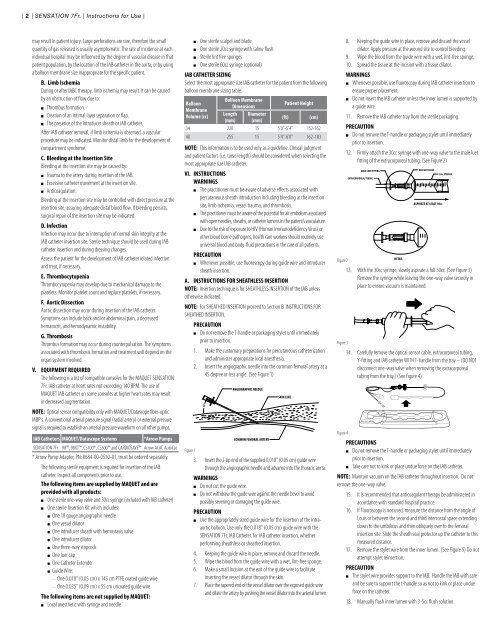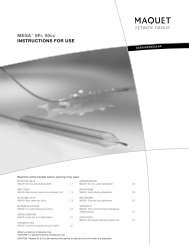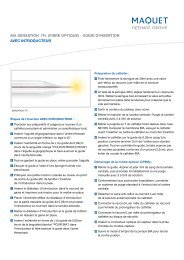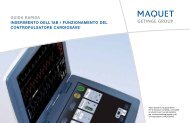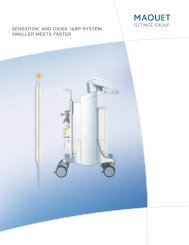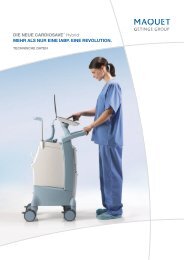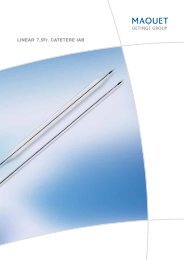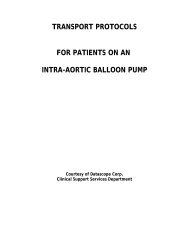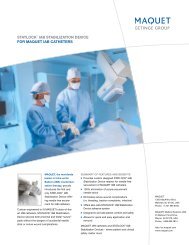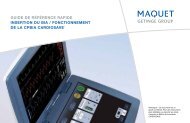SENSATION® 7Fr. IAB CATHETER INSTRUCTIONS FOR USE
SENSATION® 7Fr. IAB CATHETER INSTRUCTIONS FOR USE
SENSATION® 7Fr. IAB CATHETER INSTRUCTIONS FOR USE
You also want an ePaper? Increase the reach of your titles
YUMPU automatically turns print PDFs into web optimized ePapers that Google loves.
| 2 | SENSATION <strong>7Fr</strong>. | Instructions for Use |<br />
may result in patient injury. Large perforations are rare, therefore the small<br />
quantity of gas released is usually asymptomatic. The rate of incidence at each<br />
individual hospital may be influenced by the degree of vascular disease in that<br />
patient population, by the location of the <strong>IAB</strong> catheter in the aorta, or by using<br />
a balloon membrane size inappropriate for the specific patient.<br />
B. Limb Ischemia<br />
During or after <strong>IAB</strong>C therapy, limb ischemia may result. It can be caused<br />
by an obstruction of flow due to:<br />
Thrombus formation.<br />
Creation of an intimal layer separation or flap.<br />
The presence of the introducer sheath or <strong>IAB</strong> catheter.<br />
After <strong>IAB</strong> catheter removal, if limb ischemia is observed, a vascular<br />
procedure may be indicated. Monitor distal limb for the development of<br />
compartment syndrome.<br />
C. Bleeding at the Insertion Site<br />
Bleeding at the insertion site may be caused by:<br />
Trauma to the artery during insertion of the <strong>IAB</strong>.<br />
Excessive catheter movement at the insertion site.<br />
Anticoagulation.<br />
Bleeding at the insertion site may be controlled with direct pressure at the<br />
insertion site, assuring adequate distal blood flow. If bleeding persists,<br />
surgical repair of the insertion site may be indicated.<br />
D. Infection<br />
Infection may occur due to interruption of normal skin integrity at the<br />
<strong>IAB</strong> catheter insertion site. Sterile technique should be used during <strong>IAB</strong><br />
catheter insertion and during dressing changes.<br />
Assess the patient for the development of <strong>IAB</strong> catheter related infection<br />
and treat, if necessary.<br />
E. Thrombocytopenia<br />
Thrombocytopenia may develop due to mechanical damage to the<br />
platelets. Monitor platelet count and replace platelets, if necessary.<br />
F. Aortic Dissection<br />
Aortic dissection may occur during insertion of the <strong>IAB</strong> catheter.<br />
Symptoms can include back and/or abdominal pain, a decreased<br />
hematocrit, and hemodynamic instability.<br />
G. Thrombosis<br />
Thrombus formation may occur during counterpulsation. The symptoms<br />
associated with thrombosis formation and treatment will depend on the<br />
organ system involved.<br />
V. EQUIPMENT REQUIRED<br />
The following is a list of compatible consoles for the MAQUET SENSATION<br />
<strong>7Fr</strong>. <strong>IAB</strong> catheter at heart rates not exceeding 140 BPM. The use of<br />
MAQUET <strong>IAB</strong> catheter on some consoles at higher heart rates may result<br />
in decreased augmentation.<br />
NOTE: Optical sensor compatibility only with MAQUET/Datascope fiber-optic<br />
<strong>IAB</strong>P's. A conventional arterial pressure signal (radial artery) or external pressure<br />
signal is required to establish an arterial pressure waveform on all other pumps.<br />
<strong>IAB</strong> Catheters MAQUET/Datascope Systems *Arrow Pumps<br />
SENSATION <strong>7Fr</strong>. 98, 98XT, CS100®, CS300 and CARDIOSAVE Arrow ACAT, AutoCat<br />
* Arrow Pump Adapter, PN: 0684-00-0510-01, must be ordered separately.<br />
The following sterile equipment is required for insertion of the <strong>IAB</strong><br />
catheter. Inspect all components prior to use.<br />
The following items are supplied by MAQUET and are<br />
provided with all products:<br />
One sterile one-way valve and 30cc syringe (included with <strong>IAB</strong> catheter)<br />
One sterile Insertion Kit which includes:<br />
One 18 gauge angiographic needle<br />
One vessel dilator<br />
One introducer sheath with hemostasis valve<br />
One introducer dilator<br />
One three-way stopcock<br />
One luer cap<br />
One Catheter Extender<br />
Guide Wire:<br />
— One 0.018" (0.05 cm) x 145 cm PTFE coated guide wire<br />
— One 0.035" (0.09 cm) x 55 cm uncoated guide wire<br />
The following items are not supplied by MAQUET:<br />
Local anesthetic with syringe and needle<br />
One sterile scalpel and blade<br />
One sterile 20cc syringe with saline flush<br />
Sterile lint free sponges<br />
One sterile 60cc syringe (optional)<br />
<strong>IAB</strong> <strong>CATHETER</strong> SIZING<br />
Select the most appropriate size <strong>IAB</strong> catheter for the patient from the following<br />
balloon membrane sizing table:<br />
Balloon<br />
Membrane<br />
Volume (cc)<br />
Balloon Membrane<br />
Dimensions<br />
Length Diameter<br />
(mm) (mm)<br />
Patient Height<br />
(ft) (cm)<br />
34 220 15 5'0"-5'4" 152-162<br />
40 255 15 5'4"-6'0" 162-183<br />
NOTE: This information is to be used only as a guideline. Clinical judgment<br />
and patient factors (i.e. torso length) should be considered when selecting the<br />
most appropriate size <strong>IAB</strong> catheter.<br />
VI. <strong>INSTRUCTIONS</strong><br />
WARNINGS<br />
The practitioner must be aware of adverse effects associated with<br />
percutaneous sheath introduction including bleeding at the insertion<br />
site, limb ischemia, vessel trauma, and thrombosis.<br />
The practitioner must be aware of the potential for air embolism associated<br />
with open needles, sheaths, or catheter lumens in the patient’s vasculature.<br />
Due to the risk of exposure to HIV (Human Immunodeficiency Virus) or<br />
other blood borne pathogens, health care workers should routinely use<br />
universal blood and body-fluid precautions in the care of all patients.<br />
PRECAUTION<br />
Whenever possible, use fluoroscopy during guide wire and introducer<br />
sheath insertion.<br />
A. <strong>INSTRUCTIONS</strong> <strong>FOR</strong> SHEATHLESS INSERTION<br />
NOTE: Insertion technique is for SHEATHLESS INSERTION of the <strong>IAB</strong> unless<br />
otherwise indicated.<br />
NOTE: For SHEATHED INSERTION proceed to Section B <strong>INSTRUCTIONS</strong> <strong>FOR</strong><br />
SHEATHED INSERTION.<br />
PRECAUTION<br />
Do not remove the T-handle or packaging stylet until immediately<br />
prior to insertion.<br />
1. Make the customary preparations for percutaneous catheterization<br />
and administer appropriate local anesthesia.<br />
2. Insert the angiographic needle into the common femoral artery at a<br />
45 degree or less angle. (See Figure 1)<br />
Figure 1<br />
45°<br />
ANGIOGRAPHIC NEEDLE<br />
COMMON FEMORAL ARTERY<br />
SKIN LINE<br />
3. Insert the J-tip end of the supplied 0.018" (0.05 cm) guide wire<br />
through the angiographic needle and advance into the thoracic aorta.<br />
WARNINGS<br />
Do not cut the guide wire.<br />
Do not withdraw the guide wire against the needle bevel to avoid<br />
possibly severing or damaging the guide wire.<br />
PRECAUTION<br />
Use the appropriately sized guide wire for the insertion of the Intraaortic<br />
balloon. Use only the 0.018" (0.05 cm) guide wire with the<br />
SENSATION <strong>7Fr</strong>. <strong>IAB</strong> Catheter, for <strong>IAB</strong> catheter insertion, whether<br />
performing sheathless or sheathed insertion.<br />
4. Keeping the guide wire in place, remove and discard the needle.<br />
5. Wipe the blood from the guide wire with a wet, lint-free sponge.<br />
6. Make a small incision at the exit of the guide wire to facilitate<br />
inserting the vessel dilator through the skin.<br />
7. Place the tapered end of the vessel dilator over the exposed guide wire<br />
and dilate the artery by pushing the vessel dilator into the arterial lumen.<br />
Figure 2<br />
Figure 3<br />
Figure 4<br />
8. Keeping the guide wire in place, remove and discard the vessel<br />
dilator. Apply pressure at the wound site to control bleeding.<br />
9. Wipe the blood from the guide wire with a wet, lint-free sponge.<br />
10. Spread the tissue at the incision with a tissue dilator.<br />
WARNINGS<br />
Whenever possible, use fluoroscopy during <strong>IAB</strong> catheter insertion to<br />
ensure proper placement.<br />
Do not insert the <strong>IAB</strong> catheter unless the inner lumen is supported by<br />
a guide wire.<br />
11. Remove the <strong>IAB</strong> catheter tray from the sterile packaging.<br />
PRECAUTION<br />
Do not remove the T-handle or packaging stylet until immediately<br />
prior to insertion.<br />
12. Firmly attach the 30cc syringe with one-way valve to the male luer<br />
fitting of the extracorporeal tubing. (See Figure 2)<br />
MALE LUER FITTING<br />
EXTRACORPOREAL TUBING<br />
BALLOON<br />
BALLOON<br />
DETAIL<br />
ONE-WAY VALVE<br />
5<br />
1/4<br />
10<br />
15<br />
1/2<br />
ASPIRATE AT LEAST 30cc<br />
30cc SYRINGE<br />
13. With the 30cc syringe, slowly aspirate a full 30cc. (See Figure 3)<br />
Remove the syringe while leaving the one-way valve securely in<br />
place to ensure vacuum is maintained.<br />
14. Carefully remove the optical sensor cable, extracorporeal tubing,<br />
Y-fitting and <strong>IAB</strong> catheter WITH T-handle from the tray – (DO NOT<br />
disconnect one-way valve when removing the extracorporeal<br />
tubing from the tray.) (See figure 4)<br />
PRECAUTIONS<br />
Do not remove the T-handle or packaging stylet until immediately<br />
prior to insertion.<br />
Take care not to kink or place undue force on the <strong>IAB</strong> catheter.<br />
NOTE: Maintain vacuum on the <strong>IAB</strong> catheter throughout insertion. Do not<br />
remove the one-way valve.<br />
15. It is recommended that anticoagulant therapy be administered in<br />
accordance with standard hospital practice.<br />
16. If Fluoroscopy is not used, measure the distance from the angle of<br />
Louis or between the second and third intercostal space extending<br />
down to the umbilicus and then obliquely over to the femoral<br />
insertion site. Slide the sheath seal protector up the catheter to this<br />
measured distance.<br />
17. Remove the stylet wire from the inner lumen. (See Figure 5) Do not<br />
attempt stylet reinsertion.<br />
PRECAUTION<br />
The stylet wire provides support to the <strong>IAB</strong>. Handle the <strong>IAB</strong> with care<br />
and be sure to support the t-handle so as not to kink or place undue<br />
force on the catheter.<br />
18. Manually flush inner lumen with 3-5cc flush solution.<br />
20


